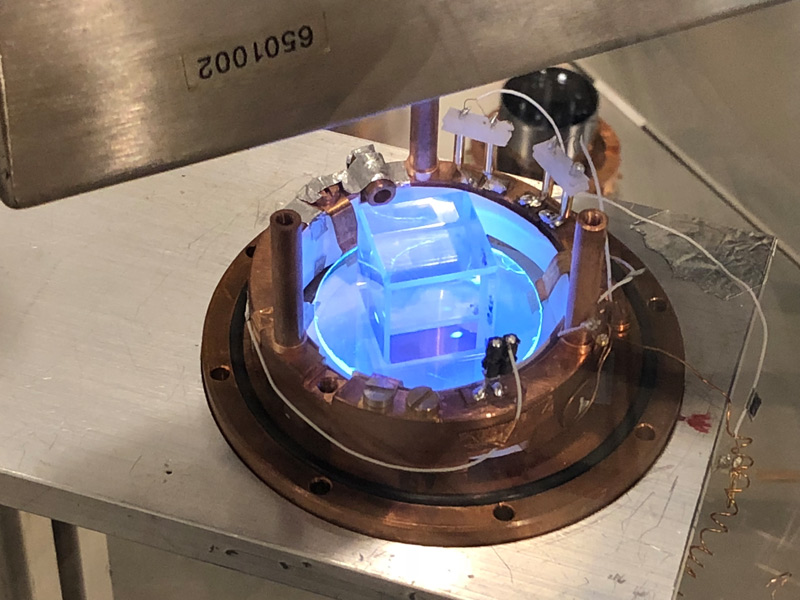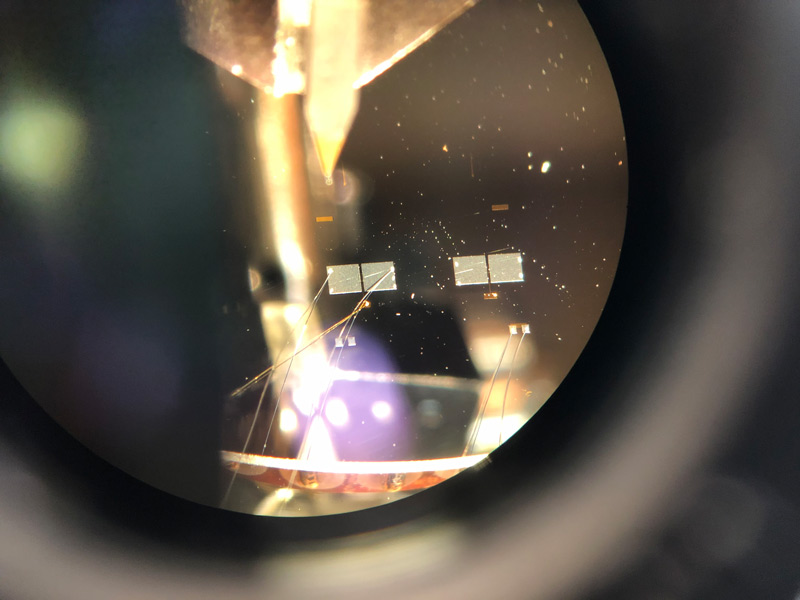How can we understand dark matter? It probably makes up around 85% of the mass in the universe. However, what it is and what it consists of remains one of the biggest and most difficult questions in modern physics. The research project COSINUS (Cryogenic Observatory for SIgnatures seen in Next-generation Underground Searches) is now being launched in Gran Sasso (Italy), which is expected to provide clarity on data that has been difficult to interpret up to now. The large-scale project is a collaboration between the Max Planck Institute of Physics in Munich, the Vienna University of Technology, the Institute of High Energy Physics of the Austrian Academy of Sciences, the Istituto Nazionale di Fisica Nucleare (Italy) and the Helsinki Institute of Physics (Finland).
A special measuring device was developed for the COSINUS project in which a crystal is cooled to extremely low temperatures in order to be able to measure the energy of particles very precisely. If the universe is full of dark matter consisting of previously unknown particles, then the Earth should collide with these particles on its way through space, and these collisions could be detected in the measuring device.
Similar data has already been collected in another experiment (DAMA/LIBRA), with unexpected but still controversial results. The global physics community is therefore eagerly awaiting the results of COSINUS.
Is the Earth plowing through a nebula of dark matter?
The sun, together with all its planets, moves around the centre of the Milky Way at a speed of around 220 kilometres per second. The Earth, in turn, orbits the sun at a speed of around 30 kilometres per second. "Over the course of a year, the Earth sometimes moves in the same direction as the Sun on its orbit, and half a year later in the opposite direction," says Florian Reindl (OeAW and TU Wien), one of the leaders of the new research project.
If our galaxy is permeated by a kind of "nebula" of dark matter, then the Earth would sometimes move faster, then slower through this dark matter nebula. "Similar to how different amounts of raindrops hit the windshield when it rains, depending on how fast you drive, you would expect to detect different amounts of dark matter depending on the season."
This is exactly what the DAMA/LIBRA experiment, which has been running since 1995, has shown: A signal was actually detected whose intensity changed regularly over the years - an indication of dark matter. However, other experiments were unable to repeat these results.
"This is a problem that has preoccupied the scientific community around the world for years," says Florian Reindl. "With our newly developed experiment, we now finally have the chance to solve this puzzle: We use sodium iodide in our detector, the same material as in the DAMA/LIBRA experiment, so we can ensure optimal comparability. However, our experimental setup will achieve significantly higher accuracy."
A "refrigerator" for extremely low temperatures
The heart of the experiment is a cryostat - a refrigerator for extremely low temperatures in which a crystal of sodium iodide can be cooled to one to two hundredths of a degree above zero. If this crystal is hit by particles, two different signals are generated: firstly, the atoms of the crystal can be set into vibration - the crystal lattice begins to wobble and heats up. The heat energy absorbed in the process is measured extremely accurately. Secondly, light is also produced in the crystal, and this light is also to be measured in the COSINUS project.
"Only by detecting both signals can we precisely analyse the energy balance of the incident particles," says Florian Reindl. In the DAMA/LIBRA experiment, only the light is measured, not the heat.
Known or unknown particles?
By examining both energy signals at the same time, it is also possible to obtain valuable information about which particles are involved. This is important because not every signal that is measured in such a detector is an indication of dark matter, explains Florian Reindl: "It can also be ordinary electrons, for example, which are produced by natural radioactivity. Or neutrons produced by muons from space." The crystal must therefore be shielded as well as possible. The experiment was therefore set up in the world's largest underground laboratory, the Laboratori Nazionali del Gran Sasso (Italy), in a mountain massif around a hundred kilometres from Rome. Deep below the earth's surface, shielded by 1400 meters of rock, measurements can be carried out. (The DAMA/LIBRA experiment is also set up there).
The detectors were also placed in the middle of a seven-metre-high tank of ultra-pure water. In addition to all these experimental measures, the data must also be very carefully evaluated and compared with each other in order to really assess the reliability of the signals.
Heinz Faßmann, President of the Austrian Academy of Sciences: "Dark matter is one of the great mysteries of physics. The matter we can see seems to be just the tip of the iceberg. So far, however, no experiment has been able to prove the existence of dark matter beyond doubt. With the combined forces of Max Planck in Germany, TU Wien and the Academy of Sciences in Austria, as well as our partners in the Italian underground laboratory Gran Sasso, we hope to finally solve this fascinating puzzle in the coming years. It would be an important step towards a better understanding of our universe."
The COSINUS project will officially open on April 18, 2024 at the Laboratori Nazionali del Gran Sasso, with the first results of the measurements expected in 2025/26.




